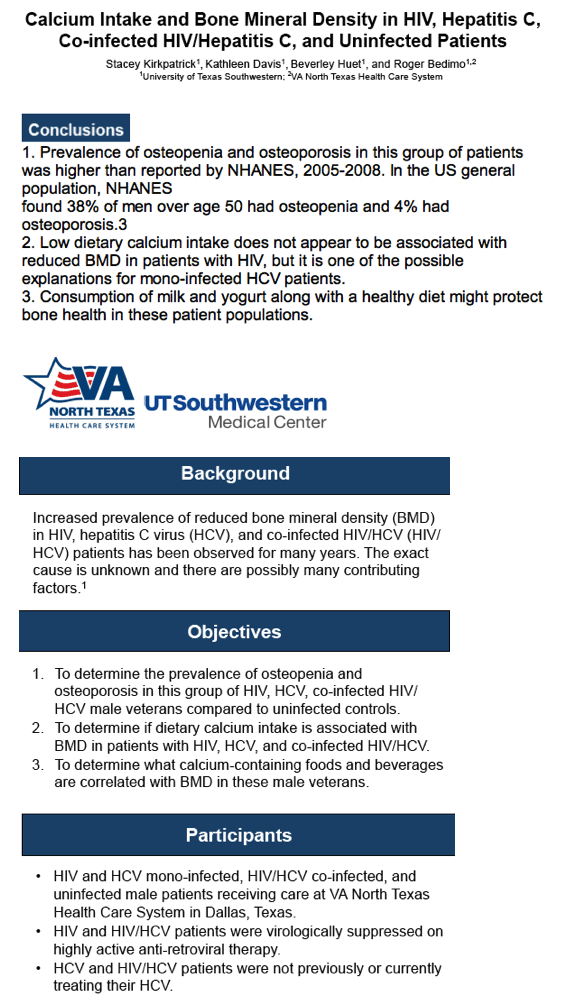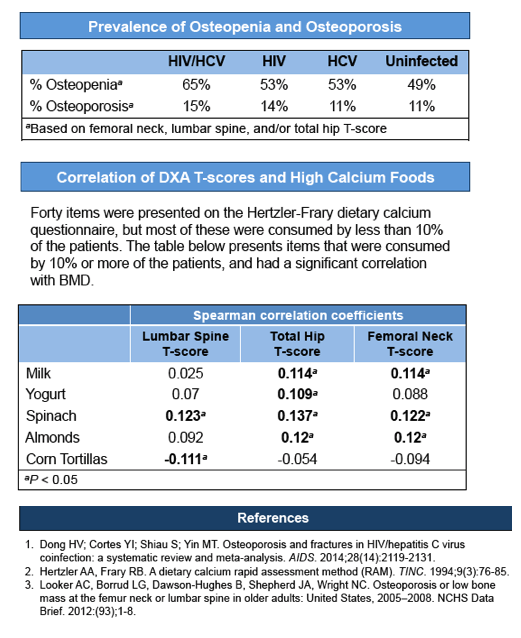 |
 |
 |
| |
Low Dietary Calcium Tied to Low Bone Density With HCV But Not HIV
|
| |
| |
IDWeek2017/IDSA, October 4-8, 2017, San Diego
Mark Mascolini
Low dietary calcium could be one driver of low bone mineral density (BMD) in male US veterans with HCV infection, according to results of a 436-veteran study [1]. But the analysis did not link dietary calcium to low BMD in veterans with HIV or HIV/HCV coinfection. Osteopenia and osteoporosis rates were much higher with HIV and/or HCV in these veterans than in the general population.

The precise causes of reduced BMD in people with HIV or HCV remain poorly understood. Researchers working with the VA North Texas Health Care System aimed to establish rates of osteopenia and osteoporosis in veterans with HIV and/or HCV, to determine whether low dietary calcium contributes to low BMD, and to see if calcium-containing foods correlate with BMD.
The study group consisted of male veterans receiving care at the VA North Texas unit with HIV or HCV monoinfection, HIV/HCV coinfection, or neither infection. All participants with HIV had an undetectable HIV load with antiretroviral therapy; no veterans with HCV had ever taken anti-HCV therapy. The researchers established baseline dietary calcium intake with the Hertzler-Frary dietary calcium rapid assessment questionnaire [2]. They determined calcium levels via the USDA Nutrient Database. Veterans had DXA scans to measure BMD at the lumbar spine, femoral neck, and total hip. The researchers used one-way analysis of covariance adjusted for age, body mass index, race, and smoking status to compare calcium intake and prevalence of normal BMD or osteoporosis between infection groups.
The study group consisted of 46 veterans with HIV/HCV, 141 with HIV alone, 99 with HCV alone, and 150 with neither virus. Age averaged 54 to 56 across the four groups, and respective proportions of blacks were 68%, 42%, 74%, and 73% (P < 0.001). The groups with HCV (68%) alone and with no infection (66%) had higher percentages of smokers than groups with HIV/HCV (48%) or with HIV alone (33%) (P < 0.001). Calcium intake did not differ significantly across the four groups, with medians of 606 mg in the HIV/HCV group, 719 mg in the HIV group, 654 mg in the HCV group, and 788 mg in uninfected controls (P = 0.409). Calcium intake with supplements also proved similar across the four groups.
T scores derived from DXA scans indicated osteopenia prevalence of 65% with HIV/HCV, 53% with HIV alone, 53% with HCV alone, and 49% in uninfected veterans. Respective rates of osteoporosis were 15%, 14%, 11%, and 11%. All differences were nonsignificant. But these rates are much higher than those reported in men over 50 in the general-population NHANES group--38% with osteopenia and 4% with osteoporosis [3].
Statistical analysis controlled for age, body mass index, race, and smoking disclosed no difference in median calcium intake between the four veteran groups (F = 0.966, P = 0.409) or in calcium intake including supplements (F = 0886, P = 0.448). Nor did median calcium intake differ significantly between veterans with HIV or HIV/HCV with normal BMD versus those with osteoporosis. But HCV-positive veterans with osteoporosis had significantly lower calcium intake than HCV-positive veterans with normal BMD (mean difference 409 mg, 95% confidence interval 35 to 784, P = 0.027).
Among the 40 items in the Hertzler-Frary dietary calcium questionnaire, 10% or more veterans reported eating five of them, four of which had a significant positive correlation with BMD at one, two, or three DXA sites: spinach (three sites), milk (two sites), almonds (two sites), and yogurt (one site). Corn tortillas had a significant negative correlation with BMD at the lumbar spine.
The researchers concluded that low dietary calcium may partly explain low BMD in veterans with HCV infection alone, but not in those with HIV alone or HIV/HCV. They suggested that "consumption of milk and yogurt along with a healthy diet might protect bone health in these patient populations."
References
1. Kirkpatrick S, Davis K, Huet B, Bedimo R. Calcium intake and bone mineral density in HIV, hepatitis C, co-infected HIV/hepatitis C, and uninfected patients. IDWeek2017/IDSA. October 4-8, 2017. San Diego. Abstract 590.
2. Hertzler AA, Frary RB. A dietary calcium rapid assessment method (RAM). Topics Clin Nutrition. 1994;9:76-85.
3. Looker AC, Borrud LG, Dawson-Hughes B, Shepherd JA, Wright NC. Osteoporosis or low bone mass at the femur neck or lumbar spine in older adults: United States, 2005-2008. NCHS Data Brief. 2012:93;1-8.



|
| |
|
 |
 |
|
|